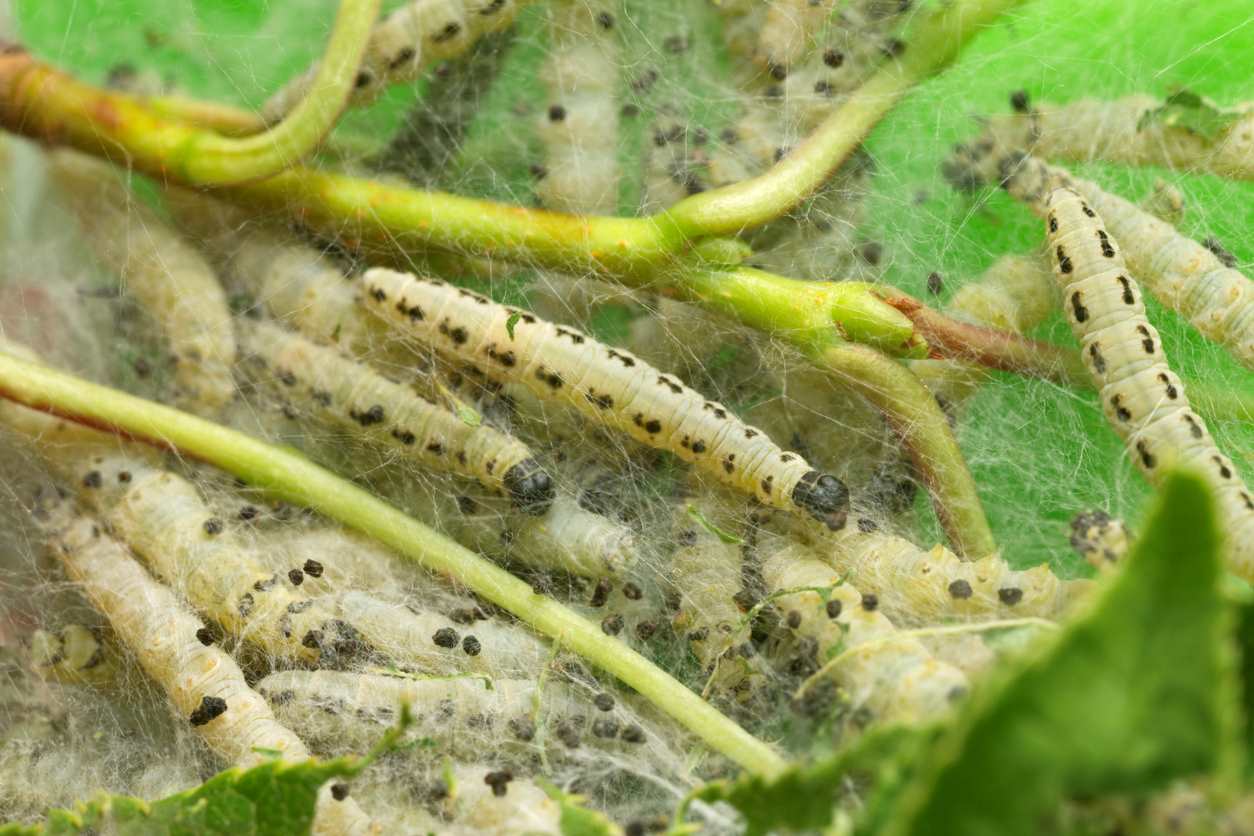
Specialized players
These weavers are butterfly larvae. Several species work in this way, but each does so on a well-defined terrain.
The charcoal hyponomemut speaks almost exclusively about those in Europe; the fruit tree hyponomemut on blackthorns and hawthorn; and that of the apple tree on the pear trees as well. As for the willow hyponomethe exercises his talents by the rivers.
When summer comes, these little white butterflies lay their eggs on carefully chosen supports. The tiny caterpillars (less than 1 mm), which are born in August, courageously spend the entire winter on their host plant. At the beginning of spring, they gather on the newly emerged leaves which they eat at full speed, without any moderation. The plants are then completely leafless.
High quality weaving
Very quickly, branches and twigs find themselves “swaddled” in fine silvery-white webs which continue to multiply. Over the weeks, this careful weaving thickens, becomes compact and very resistant. Inside, beautiful caterpillars — yellowish to greenish, with bodies dotted with small punctuations — are in full activity.
The work they created is a true refuge which allows them to face the excesses of the climate and to brave the birds. But their time of glory ends at the end of spring. Then comes the pupation period. In the center of the webs, small, compact, white masses form: the insects metamorphose.
New web weavers are emerging.
Should it be treated?
Although spectacular, hyponomemuts do not worry their hosts because they act early at the start of the summer season. From the end of spring, the covered trees and shrubs quickly manage to produce new leaves and forget about this mishap.
You can always forcefully remove these numerous woven threads by hand and eliminate the caterpillars if their presence displeases you. As for treatments, they are not very effective: these insects are perfectly protected by the cocoon they have woven.
Natural methods of combating hyponomemut
Faced with the hyponomemut, human intervention may be necessary, especially to protect young trees or those producing fruit.
Favor gentle and environmentally friendly control methods. The introduction of natural predators, such as certain birds or insects which feed on the larvae, can constitute an interesting alternative to chemical treatments. In addition, maintaining a diverse garden can help to naturally regulate the population of hyponomemuts, by favoring the presence of their natural enemies.
What prevention and control strategies should the larvae persist?
To prevent hyponomemuta infestation, several methods can be used. The application of a clay wash on trunks and branches during winter helps eliminate hibernating caterpillars. Promoting biodiversity, in particular by attracting insectivorous birds, can also contribute to the natural regulation of these butterflies.
In the event of a proven attack, the use of pheromone traps and spraying of biological insecticides such as Bacillus thuringiensis are recommended to limit their proliferation.
Identification and life cycle of hyponomemuts
The hyponomeutes, or Yponomeuta spp, are of little moths, recognizable by their white forewings decorated with black dots and their light brown hindwings. Their life cycle begins with the laying of eggs in late summer, followed by a period of hibernation for the caterpillars, which in spring emerge to feed voraciously on nearby leaves and buds. This feast is accompanied by the creation of protective silk webs, visually marking their presence in gardens and orchards.
Impact on plants and corrective measures
Although the appearance of trees and shrubs infested with hyponomemuts may seem alarming, most plants recover quickly after an attack. Caterpillars do defoliate plants, but they are usually able to produce new leaves shortly after. For more severe cases, particularly on young trees or in orchards, direct interventions may be necessary to safeguard the health and productivity of the plants concerned.
Biodiversity at the heart of the phenomenon
The existence of hyponomemuts, far from being a simple aesthetic inconvenience, underlines the importance of biodiversity in our ecosystems. These little beings, although considered harmful by some, play a crucial role in the food chain.
Indeed, birds, in particular, feed on these larvae, finding in these “veils” an abundant source of food in spring. This interaction reminds us of the importance of each species, even the smallest, in maintaining ecological balance.
The role of citizens in surveillance
Early detection of hyponomeute infestations is crucial to limit their impact. Citizens can play an active role by monitoring the trees and shrubs in their garden or nearby environment.
By learning to recognize the warning signs, such as the appearance of the first curtains, they can intervene quickly, by manually removing the canvases or calling in professionals if necessary. This collective vigilance contributes to the sustainable management of green spaces and the protection of our natural resources.

